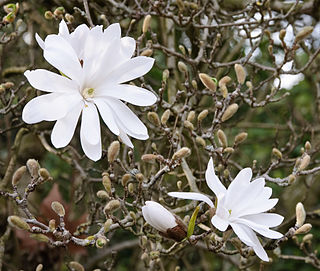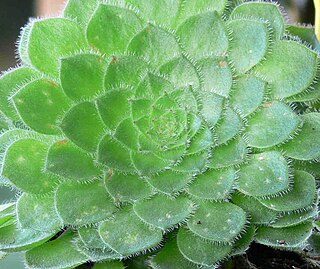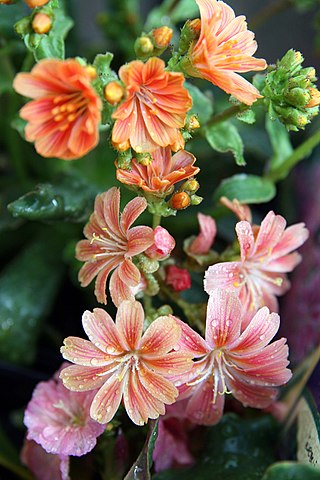
Nicotiana is a genus of herbaceous plants and shrubs in the family Solanaceae, that is indigenous to the Americas, Australia, Southwestern Africa and the South Pacific. Various Nicotiana species, commonly referred to as tobacco plants, are cultivated as ornamental garden plants. N. tabacum is grown worldwide for the cultivation of tobacco leaves used for manufacturing and producing tobacco products, including cigars, cigarillos, cigarettes, chewing tobacco, dipping tobacco, snuff, and snus.

Magnolia stellata, the star magnolia, is a slow-growing deciduous shrub or small tree native to Japan. It bears large, showy white or pink flowers in early spring, before its leaves open. This species is closely related to the Kobushi magnolia, and is treated by many botanists as a variety or even a cultivar of that. However, Magnolia stellata was accepted as a distinct species in the 1998 monograph by Hunt.

Silene chalcedonica, the Maltese-cross or scarlet lychnis, is a species of flowering plant in the family Caryophyllaceae, native to Eurasia. Other common names include flower of Bristol, Jerusalem cross and nonesuch.

Hyacinthus orientalis, the common hyacinth, garden hyacinth or Dutch hyacinth, is a species of flowering plant in the family Asparagaceae, subfamily Scilloideae, native to southwestern Asia, southern and central Turkey, northwestern Syria, Lebanon and northern Palestine. It was introduced to Europe in the 16th century. It is widely cultivated everywhere in the temperate world for its strongly fragrant flowers which appear exceptionally early in the season, and frequently forced to flower at Christmas time.

Lobularia maritima is a species of low-growing flowering plant in the family Brassicaceae. Its common name is sweet alyssum or sweet Alison, also commonly referred to as just alyssum.

Salvia splendens, the scarlet sage, is a tender herbaceous perennial plant native to Brazil, growing at 2,000 to 3,000 m elevation where it is warm year-round and with high humidity. The wild form, rarely seen in cultivation, reaches 1.3 m (4.3 ft) tall. Smaller cultivars are very popular as bedding plants, seen in shopping malls and public gardens all over the world.

Lavandula angustifolia, formerly L. officinalis, is a flowering plant in the family Lamiaceae, native to the Mediterranean. Its common names include lavender, true lavender and English lavender ; also garden lavender, common lavender and narrow-leaved lavender.

Nicotiana tabacum, or cultivated tobacco, is an annually grown herbaceous plant of the genus Nicotiana. N. tabacum is the most commonly grown species in the genus Nicotiana, as the plant's leaves are commercially harvested to be processed into tobacco for human use. The plant is tropical in origin, is commonly grown throughout the world, and is often found in cultivation. It grows to heights between 1 to 2 metres. Research is ongoing into its ancestry among wild Nicotiana species, but it is believed to be a hybrid of Nicotiana sylvestris, N. tomentosiformis, and possibly N. otophora.

Vinca major, with the common names bigleaf periwinkle, large periwinkle, greater periwinkle and blue periwinkle, is a species of flowering plant in the family Apocynaceae, native to the western Mediterranean. Growing to 25 cm (10 in) tall and spreading indefinitely, it is an evergreen perennial, frequently used in cultivation as groundcover.

Bistorta affinis, the Himalayan bistort, fleece flower, or knotweed, is a species of flowering plant in the family Polygonaceae, native to the Himalayas.

Angelica sylvestris or wild angelica is a species of flowering plant, native to Europe and central Asia. An annual or short-lived perennial growing to a maximum of 2.5 metres (8.2 ft), it has erect purplish stems and rounded umbels of minuscule white or pale pink flowers in late summer.

Rudbeckia triloba, the browneyed or brown-eyed susan, thin-leaved coneflower or three-leaved coneflower, is a species of flowering plant in the family Asteraceae with numerous, yellow, daisy-like flowers. It is native to the central and eastern United States and is often seen in old fields or along roads. It is also cultivated as an ornamental.

Darmera peltata, the Indian rhubarb or umbrella plant, is a flowering plant, the only species within the genus Darmera in the family Saxifragaceae. It is a slowly spreading rhizomatous perennial native to mountain streamsides in woodland in the western United States, growing to 2 m tall by 1 m wide. The name Darmera honours Karl Darmer, a 19th-century German horticulturist.

Digitalis grandiflora, the yellow foxglove, big-flowered foxglove, or large yellow foxglove, is a species of flowering plant in the genus Digitalis, family Plantaginaceae. It is native to southern Europe and Asia. In mountains it grows on warm, bushy slopes or areas left after logging. The Latin specific epithet grandiflora means “large flowered”.

Erysimum cheiri, syn. Cheiranthus cheiri, the wallflower, is a species of flowering plant in the family Brassicaceae (Cruciferae), native to Greece, but widespread as an introduced species elsewhere. It is also treated as a hybrid under the name Erysimum × cheiri. It is widely cultivated as a garden plant.

Phlomis fruticosa, the Jerusalem sage, is a species of flowering plant in the family Lamiaceae, native to Albania, Croatia, Cyprus, Greece, Italy, Monte Negro and Turkey.

Aeonium tabuliforme, the flat-topped aeonium or saucer plant, is a species of succulent plant in the family Crassulaceae, native and endemic to Tenerife in the Canary Islands. It is low-growing, typically reaching about 5 cm high but up to 45 cm in diameter. It grows on moist, north-facing cliffs and ledges at low altitude. A mass of fleshy, hairy, bright green leaves in flat rosettes is produced on short unbranched stems, often on vertical surfaces. This species is short-lived and dies after flowering. Plants often take 3–4 years to flower, at which point they produce a tall (40–60 cm) raceme of yellow flowers.

Lewisia cotyledon is a species of flowering plant in the family Montiaceae known by the common names Siskiyou lewisia and cliff maids. It is native to southern Oregon and northern California, where it grows in rocky subalpine mountain habitat.

Veltheimia capensis is one of two species of flowering plants belonging to the genus Veltheimia, of the family Asparagaceae. It is a tender bulbous perennial reaching a height of 46 cm (18 in), with flowers varying in color from white with red spots to pink with green or red markings.

Nicotiana langsdorffii, Langsdorff's tobacco, is a species of flowering plant in the nightshade family Solanaceae, native to Brazil. Growing to 1.5 m (4.9 ft) tall by 0.5 m (1.6 ft) broad, it is an annual plant with large sticky leaves up to 10 in (25 cm) long. It bears 2 in (5.1 cm) long, nodding, tubular bell-shaped flowers that are apple green in colour, with blue anthers. N. langsdorfii lacks fragrance, unlike some of the other tall species. It is grown as an ornamental garden plant.




















